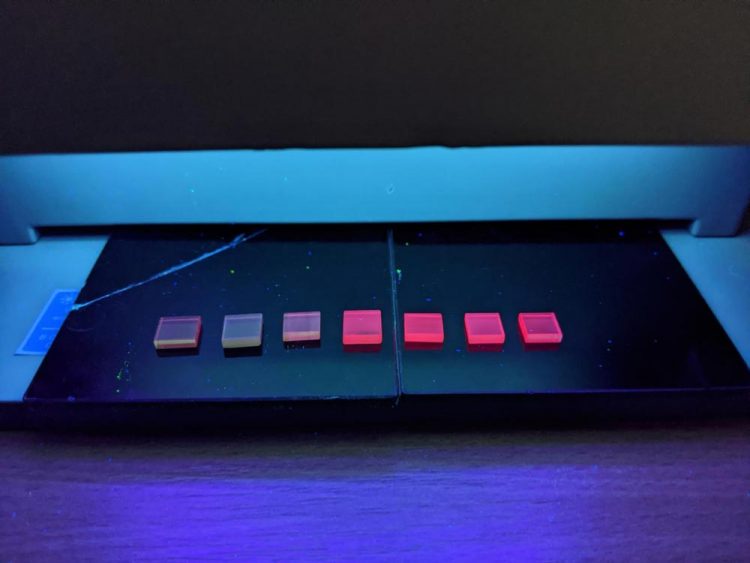New light for plants

Scientists from ITMO in collaboration with their colleagues from Tomsk Polytechnic University came up with an idea to create light sources from ceramics with the addition of chrome: the light from such lamps offers not just red but also infrared (IR) light, which is expected to have a positive effect on plants' growth. The research was completed as part of a Russian Science Foundation grant, and the results were published in Optical Materials. Credit: Anastasiia Babkina
Many may have seen bright pink light in some windows – it comes from special lamps that are used for providing sufficient lighting to house plants. Similar lamps are also used by farmers in greenhouses. Still, specialists in photophysiology argue that such lamps do not provide all the light that plants need. Scientists from ITMO in collaboration with their colleagues from Tomsk Polytechnic University came up with an idea to create light sources from ceramics with the addition of chrome: the light from such lamps offers not just red but also infrared (IR) light, which is expected to have a positive effect on plants' growth. The research was completed as part of a Russian Science Foundation grant, and the results were published in Optical Materials.
Growing vegetables, fruit and berries in huge greenhouses rather than in the open is becoming more and more common. In such facilities, plants are protected from hail, droughts and chill. Then again, farmers have to compensate for the lack of natural sunlight in such greenhouses. Advanced agricultural facilities use light diodes for this purpose: they consume little energy, give bright light and can be easily set up in a greenhouse. The light they emit is pink, which is produced by simultaneous use of blue and red diodes.
“Scientists found out that such lighting isn't optimal,” says Anastasia Babkina, a lab assistant at the Faculty of Photonics and Optical Information. “Thing is, a red diode lights in the range of about 650 nanometers, and its spectrum is very narrow, similar to that of a laser. Plants, however, absorb red and IR light better in the range that's a bit more than 650 nanometers, which people can barely see. So you see, this means that we use the light that's more comfortable for humans and not optimal for plants.”
All this means that we need to find a material that can be used in light diode lamps in such a way that they would produce light of a wider spectrum, including the IR range. A group of researchers from ITMO and Tomsk Polytechnic University took up this task. Classical red light diodes use materials based on manganese and europium compounds. The crystals of this chemical element make the diode emit at the wavelength of about 650 nanometers, making the light red, and jointly with the emission of the blue diode – pink.
“We decided to use not a different crystal but glass-ceramics,” says Anastasia Babkina. “This is a transitive material between glass and crystal. What's the difference? We have to specifically grow crystals, whereas glass is synthesized by moulding, and it can be produced quickly and in large amounts, in any shape you need. The drawback is that glass is fragile. For this reason, we take glass and begin to slowly crystallize it so that it doesn't lose transparency. In result, we get glass with microscopic crystals inside that are invisible to the eye. Such a material is more sturdy, has better luminescent properties – and is called glass-ceramics.”
Chrome is added to glass-ceramics at the production stage: this gives the material a pink tone that allows it to produce red and IR light at the same time. There are two potential applications for the new material.The first is to mill it to get microparticles which can be used to produce a new type of light diodes. This offers great prospects, but the introduction of such a technology calls for a lot of time and money. Another option is to use it to create lampshades.
“We can take blue and green light diodes and use our glass-ceramics as a filter to obtain a wide-spectrum emission that will include the IR range,” explains Anastasia Babkina.
Media Contact
More Information:
http://dx.doi.org/10.1016/j.optmat.2020.109983All latest news from the category: Agricultural and Forestry Science
Newest articles

First-of-its-kind study uses remote sensing to monitor plastic debris in rivers and lakes
Remote sensing creates a cost-effective solution to monitoring plastic pollution. A first-of-its-kind study from researchers at the University of Minnesota Twin Cities shows how remote sensing can help monitor and…

Laser-based artificial neuron mimics nerve cell functions at lightning speed
With a processing speed a billion times faster than nature, chip-based laser neuron could help advance AI tasks such as pattern recognition and sequence prediction. Researchers have developed a laser-based…

Optimising the processing of plastic waste
Just one look in the yellow bin reveals a colourful jumble of different types of plastic. However, the purer and more uniform plastic waste is, the easier it is to…



